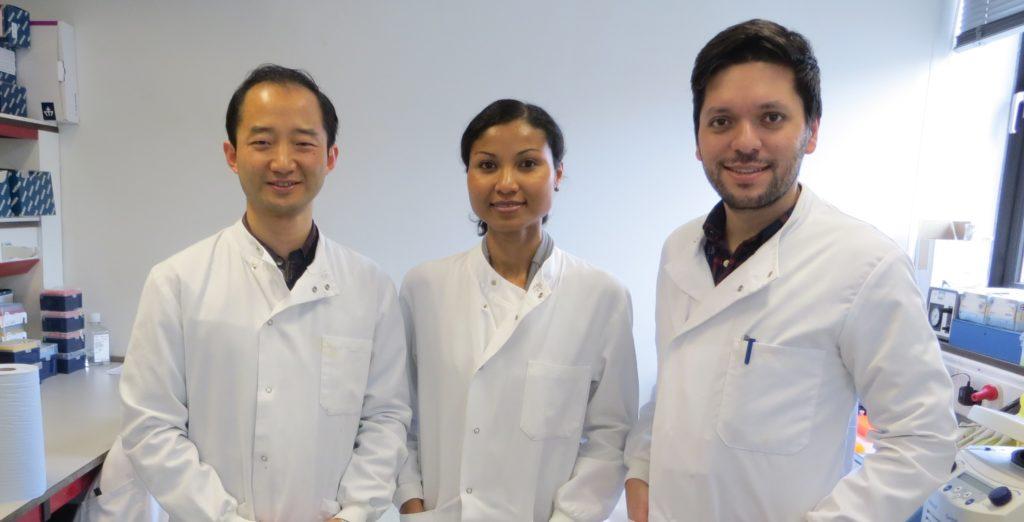Follicular lymphoma marked by spatial tumour heterogeneity
A challenge for targeted therapy
A research team at the BCI, Queen Mary University of London, led by Dr Jessica Okosun, Centre for Haemato-Oncology, has found that tumours at different sites within the same patient with follicular lymphoma can be genetically diverse. This suggests that a sole biopsy is incapable of capturing all the genetic events in any given individual and presents a significant challenge when providing targeted therapies to treat this disease.
Follicular lymphoma is an incurable blood cancer that is characterised by the production of abnormal B lymphocytes (a type of white blood cell involved in fighting infection) that accumulate primarily in the lymph nodes and bone marrow. Approximately 2,300 cases of follicular lymphoma are diagnosed in the UK each year.

In this proof-of-principle study, the team examined nine patients with advanced follicular lymphoma by collecting tumour biopsies from two different sites and analysed the DNA sequences of these samples in order to build a profile of the genetic changes that occurred in the cancer at the different locations.
Whilst it has been recognised that heterogeneity (diversity) exists between patients with follicular lymphoma, the knowledge of genetic diversity within the same patient (referred to as spatial genetic heterogeneity) had been limited until the findings of this study- published in Leukemia. They found that in every patient some genetic changes occurred at one tumour site but did not match the changes at a second site.
Considerations for targeted therapy
Although there was consistency between the genetic changes that occurred at the various tumour sites, the differences became more pronounced when the patient’s cancer progressed. This spatial genetic heterogeneity has clinical implications when considering targeted therapy.
Targeted therapies are designed to interfere with specific genetic changes, molecules or pathways unique to cancer cells, limiting the damage incurred to normal cells. However, administering a treatment based on the genetic characteristics identified from a biopsy of only one tumour site may result in patients having a sub-par response to the therapy if other tumour sites do not possess the genetic features to make them susceptible to the treatment.
Challenging current clinical practice
Current clinical practice requires a biopsy to be collected from only one site in the majority of cases. The findings of this study, conducted in collaboration with researchers from Queen Mary, Université de Rennes 1 and Cancer Research UK (CRUK) Southampton, suggest that a single biopsy may not be sufficient to capture the heterogeneity of a patient’s disease to allow for the most effective course of therapy to be utilised.
Furthermore, biopsy samples are used to identify specific genetic changes, known as prognostic biomarkers, which can be used to predict the behaviour of a patient’s cancer. Using prognostic markers only present at one site of the disease could potentially result in misclassification of the patient’s risk.
What are the next steps?
Dr Okosun said:
The findings of our study prompt us to rethink how we can deliver on the goal of precision medicine in lymphoma. We believe the first steps are to conduct clinical trials assessing targeted therapies focussed on genetic changes that are shared across all biopsies whilst in parallel continuing to increase our understanding of the extent and complexity of tumour heterogeneity with larger studies.
Although collecting biopsies from numerous sites could more effectively capture a patient’s heterogeneity, this is not conceivable due to the invasive nature of the procedure. As a solution, the team propose that a liquid biopsy- samples of circulating blood- may provide a better snapshot of the genetic defects present at the different cancer sites around the body. This is something that the team would like to investigate in the future.
The work was supported by the Kay Kendall Leukaemia fund, CRUK, Bloodwise, Centre for Genomic Health, Queen Mary University of London, Carte d’Identité des Tumeurs, Ligue National contre le Cancer, Pôle de biologie hospital universitaire de Rennes, CRB-Santé of Rennes and CeVi/Carnot program.
Category: General News, Publications

No comments yet